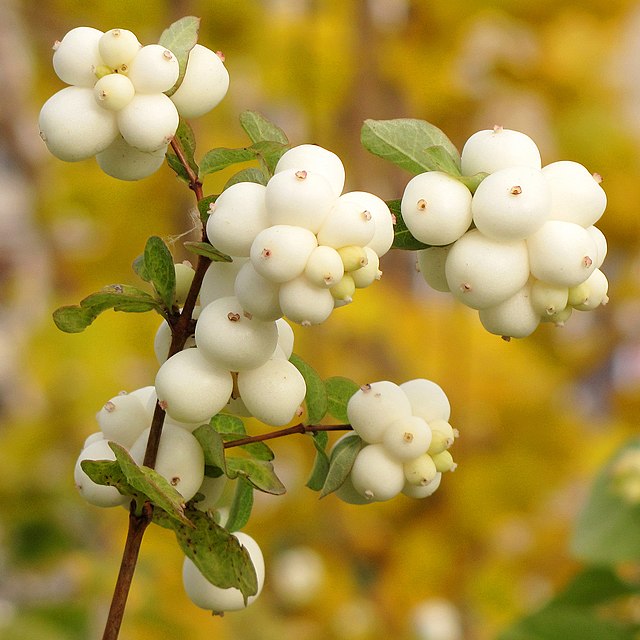are In this article, we will discover how to grow Symphoricarpos, the Snowberry, in containers. Symphoricarpos, which has the common name of snowberry, waxberry or ghostberry, is a genus of 15 species that belong to the Caprifoliaceae (the Honeysuckle) family. Apart from one species that Symphoricarpos sinensis which is naturally found growing in Western China, all other species are found in Northern or Central America. Its name comes about from the combination of two ancient Greek words- ‘Sumphorein’ meaning ‘to bear together’ and ‘Karpos’ meaning ‘Fruit’. This name comes about because the berries that form in autumn are closely packed together.

The main reason to grow this shrub is that it will flourish no matter what soil type is used. If it is grown in full sun or deep shade. It can grow under extreme growing conditions, and naturally can grow in steep hillsides, near riverbanks and close to streams.
Symphoricarpos have long, rounded, 1 to 5cm long, green leaves that are entire with one to two lobes at the base. In summer, small, insignificant, green-white or pink flowers appear in small clusters of 5 to 15. In one species Symphoricarpos microphyllus the flowers grow in pairs.
THEY ARE GROWN FOR THE BERRIES
The flowers in autumn, all the way to winter and beyond, are followed by a mass of marble-like berries. The berries are either white, pink, red or purplish-black in S. sinensis. When the white berries split open, the interior looks like fine, granular snow (hence its common name). The fleshy fruit contains two, 2 to 5cm long, whitish stones. One interesting part is that these stones are very tough and have a hard, impermeable covering and this covering makes it hard to germinate. In fact, they can be dormant for up to ten years.
Find out how to grow Symphoricarpos in containers in this article.
GROWING SYMPHORICARPOS IN CONTAINERS
First, choose a large enough container that has a few drainage holes at the bottom. As the plant has a suckering habit, it is would be wise to grow in a half-barrel container. Fill the container with a 2cm layer of gravel to allow any excess moisture to drain away.
On top of the gravel, add any compost you have available, be it ericaceous or multipurpose. Fill the container to within 5cm below the top rim, with this compost.

Dig a hole at the centre of the container slightly bigger than the root ball it came in the original pot you bought it in. Plant it so that the top of the root ball is at the same level as the top surface of the compost in the container. Backfill with the growing media so that no visible gaps remain, using more compost if you find it necessary. Firm the shrub in and water very well.
THE BEST GROWING CONDITIONS
As stated earlier the shrub can be grown in full sun or total shade, it does not matter, as it will thrive under these conditions. The only exception is that variegated varieties must be grown in full sun or they will not do well.
Watering is important as the compost must be moist at all times, especially so until it is well–established. After that, it is advised to water when 5cm below the top surface of the compost feels dry to the touch. Water until it just emerges from the drainage holes.
As they can be rampant I would not fertilize unless the plant is showing obvious signs of a nutrient deficiency. If that is the case I would give a feed with a liquid-based, general-purpose fertilizer such as Phostrogen.

To prune, you will need to remove one-third of all old stems in early spring, allowing the others to grow on. You should renew a third every year so that after 3 years all old stems will be new.
Propagation is via several methods. Method 1 is by softwood cuttings taken in summer. Method 2 is with hardwood cuttings taken in autumn and method 3 is by removing and planting root suckers. This can be left in the open and does not need to be placed under the cover of a cold frame.
PESTS AND DISEASES
The good news is that it does not suffer from any known pests and diseases, and therefore makes a great shrub to grow in containers.
VARIETIES TO GROW
There are many species and varieties that can be grown in the UK and are widely available.
This includes Symphoricarpos albus which grows up to 2m tall and produces the atypical white berries in autumn.
Noted varieties include ‘Magical Candy’ (80cm tall with pink berries), ‘Magical Galaxy’ (80cm high with masses of white berries) and ‘Arvid’ (50cm tall with white berries).

Symphoricarpos rivularis very similar to S. albus, but it tends to sucker freely and it forms a thicket of tall bluish stems full of white berries.
A ground-covering species is Symphoricarpos x chenaultii ‘Hancock’ which only grows up to 60cm tall and has purplish-pink berries. Another noted variety is ‘Brain de Soleil’ which has golden leaves.
Symphoricarpos orbiculatus, on the other hand, bears white flowers that are followed by pale purple berries.
There is a variegated variety called ‘Variegatus’ that has yellow-edged leaves but it does not readily form berries.
A final species of note is the beautiful compact and does not sucker of Symphoricarpos x doorenbosii. Several varieties are possible including ‘Magic Berry’ (1m tall with rose-pink berries), ‘Mother of Pearl’ (1.33m tall with pink-flushed white berries), ‘Amenyst’ (1.33m tall with pink-flushed white berries) and ‘White Hedge’ (60cm tall with pure white berries).
CONCLUSIONS
In this article, we have discovered how to grow the beautiful berry-forming shrub of Symphoricarpos in containers. It is probably one of the easiest shrubs to grow and will take harsh conditions, even growing in full shade. They are easy to grow, easy to care for, do not suffer from pests or diseases and you have plenty of choice as to what species and varieties can be grown.
If you have any questions or comments that you would like to make on growing Symphoricarpos in containers, please do so in the comment box below.
Happy Symphoricarpos growing.
